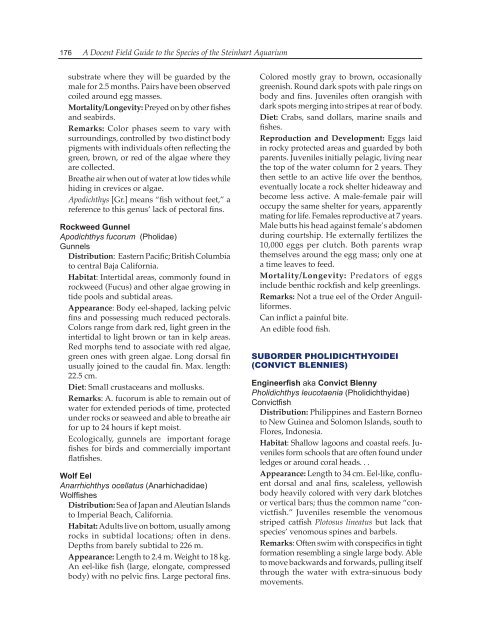THE STEINHART AQUARIUM - Gulf of Guinea Science ...
THE STEINHART AQUARIUM - Gulf of Guinea Science ...
THE STEINHART AQUARIUM - Gulf of Guinea Science ...
Create successful ePaper yourself
Turn your PDF publications into a flip-book with our unique Google optimized e-Paper software.
176 A Docent Field Guide to the Species <strong>of</strong> the Steinhart Aquarium<br />
substrate where they will be guarded by the<br />
male for 2.5 months. Pairs have been observed<br />
coiled around egg masses.<br />
Mortality/Longevity: Preyed on by other fishes<br />
and seabirds.<br />
Remarks: Color phases seem to vary with<br />
surroundings, controlled by two distinct body<br />
pigments with individuals <strong>of</strong>ten reflecting the<br />
green, brown, or red <strong>of</strong> the algae where they<br />
are collected.<br />
Breathe air when out <strong>of</strong> water at low tides while<br />
hiding in crevices or algae.<br />
Apodichthys [Gr.] means “fish without feet,” a<br />
reference to this genus’ lack <strong>of</strong> pectoral fins.<br />
Rockweed Gunnel<br />
Apodichthys fucorum (Pholidae)<br />
Gunnels<br />
Distribution: Eastern Pacific; British Columbia<br />
to central Baja California.<br />
Habitat: Intertidal areas, commonly found in<br />
rockweed (Fucus) and other algae growing in<br />
tide pools and subtidal areas.<br />
Appearance: Body eel-shaped, lacking pelvic<br />
fins and possessing much reduced pectorals.<br />
Colors range from dark red, light green in the<br />
intertidal to light brown or tan in kelp areas.<br />
Red morphs tend to associate with red algae,<br />
green ones with green algae. Long dorsal fin<br />
usually joined to the caudal fin. Max. length:<br />
22.5 cm.<br />
Diet: Small crustaceans and mollusks.<br />
Remarks: A. fucorum is able to remain out <strong>of</strong><br />
water for extended periods <strong>of</strong> time, protected<br />
under rocks or seaweed and able to breathe air<br />
for up to 24 hours if kept moist.<br />
Ecologically, gunnels are important forage<br />
fishes for birds and commercially important<br />
flatfishes.<br />
Wolf Eel<br />
Anarrhichthys ocellatus (Anarhichadidae)<br />
Wolffishes<br />
Distribution: Sea <strong>of</strong> Japan and Aleutian Islands<br />
to Imperial Beach, California.<br />
Habitat: Adults live on bottom, usually among<br />
rocks in subtidal locations; <strong>of</strong>ten in dens.<br />
Depths from barely subtidal to 226 m.<br />
Appearance: Length to 2.4 m. Weight to 18 kg.<br />
An eel-like fish (large, elongate, compressed<br />
body) with no pelvic fins. Large pectoral fins.<br />
Colored mostly gray to brown, occasionally<br />
greenish. Round dark spots with pale rings on<br />
body and fins. Juveniles <strong>of</strong>ten orangish with<br />
dark spots merging into stripes at rear <strong>of</strong> body.<br />
Diet: Crabs, sand dollars, marine snails and<br />
fishes.<br />
Reproduction and Development: Eggs laid<br />
in rocky protected areas and guarded by both<br />
parents. Juveniles initially pelagic, living near<br />
the top <strong>of</strong> the water column for 2 years. They<br />
then settle to an active life over the benthos,<br />
eventually locate a rock shelter hideaway and<br />
become less active. A male-female pair will<br />
occupy the same shelter for years, apparently<br />
mating for life. Females reproductive at 7 years.<br />
Male butts his head against female’s abdomen<br />
during courtship. He externally fertilizes the<br />
10,000 eggs per clutch. Both parents wrap<br />
themselves around the egg mass; only one at<br />
a time leaves to feed.<br />
Mortality/Longevity: Predators <strong>of</strong> eggs<br />
include benthic rockfish and kelp greenlings.<br />
Remarks: Not a true eel <strong>of</strong> the Order Anguilliformes.<br />
Can inflict a painful bite.<br />
An edible food fish.<br />
SUBORDER PHOLIDICHTHYOIDEI<br />
(CONVICT BLENNIES)<br />
Engineerfish aka Convict Blenny<br />
Pholidichthys leucotaenia (Pholidichthyidae)<br />
Convictfish<br />
Distribution: Philippines and Eastern Borneo<br />
to New <strong>Guinea</strong> and Solomon Islands, south to<br />
Flores, Indonesia.<br />
Habitat: Shallow lagoons and coastal reefs. Juveniles<br />
form schools that are <strong>of</strong>ten found under<br />
ledges or around coral heads. . .<br />
Appearance: Length to 34 cm. Eel-like, confluent<br />
dorsal and anal fins, scaleless, yellowish<br />
body heavily colored with very dark blotches<br />
or vertical bars; thus the common name “convictfish.”<br />
Juveniles resemble the venomous<br />
striped catfish Plotosus lineatus but lack that<br />
species’ venomous spines and barbels.<br />
Remarks: Often swim with conspecifics in tight<br />
formation resembling a single large body. Able<br />
to move backwards and forwards, pulling itself<br />
through the water with extra-sinuous body<br />
movements.


